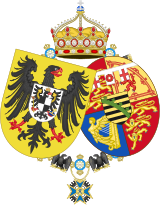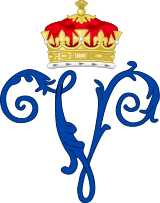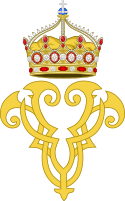Victoria, Princess Royal
This article needs additional citations for verification. (January 2016) |
| Victoria | |||||
|---|---|---|---|---|---|
| Princess Royal | |||||
 | |||||
| German Empress consort Queen consort of Prussia | |||||
| Tenure | 9 March 1888 – 15 June 1888 | ||||
| Born | 21 November 1840 Buckingham Palace, London, England | ||||
| Died | 5 August 1901 (aged 60) Schloss Friedrichshof, Kronberg im Taunus, Grand Duchy of Hesse, German Empire | ||||
| Burial | 13 August 1901 | ||||
| Spouse | Frederick III, German Emperor | ||||
| Issue | Wilhelm II, German Emperor Charlotte, Duchess of Saxe-Meiningen Prince Henry of Prussia Prince Sigismund of Prussia Viktoria, Princess Adolf of Schaumburg-Lippe Prince Waldemar of Prussia Sophia, Queen of the Hellenes Margaret, Landgravine of Hesse-Kassel | ||||
| |||||
| House | Saxe-Coburg and Gotha | ||||
| Father | Albert, Prince Consort | ||||
| Mother | Queen Victoria | ||||
Victoria, Princess Royal (Victoria Adelaide Mary Louisa;[1][2][3] 21 November 1840 – 5 August 1901) was German Empress and Queen of Prussia by marriage to German Emperor Frederick III. After her husband's death, she became widely known as Empress Frederick (German: Kaiserin Friedrich).
She was the eldest child of Queen Victoria of Great Britain and Ireland and Prince Albert. She was created Princess Royal of Great Britain and Ireland in 1841. She was the mother of Wilhelm II, German Emperor.
Early life

Princess Victoria was born on 21 November 1840 at Buckingham Palace, London. Her mother and namesake was Queen Victoria, the only child of George III's fourth eldest son, Prince Edward, Duke of Kent and Strathearn and Princess Victoria of Saxe-Coburg-Saalfeld. Her father was Prince Albert of Saxe-Coburg and Gotha the second and younger son of Ernest I, Duke of Saxe-Coburg and Gotha and Princess Louise of Saxe-Gotha-Altenburg.
She was baptised in the Throne Room of Buckingham Palace on 10 February 1841 (on her parents' first wedding anniversary) by the Archbishop of Canterbury, William Howley. The Lily font was commissioned especially for the occasion of her christening.[4] Her godparents were Queen Adelaide (her maternal grandfather's sister-in-law), King Leopold I of Belgium (maternal grandmother's brother), Ernst I, Duke of Saxe-Coburg and Gotha (paternal grandfather; for whom The Duke of Wellington, Tory Leader in the Lords, stood proxy), The Duke of Sussex (maternal grandfather's brother), The Duchess of Gloucester (maternal grandfather's sister) and The Duchess of Kent (maternal grandmother).[5]
As a daughter of the sovereign, Victoria was automatically a British princess with the style Her Royal Highness, styled HRH The Princess Victoria (and in addition being heiress presumptive to the throne of the United Kingdom before the birth of her younger brother Prince Albert, later Edward VII on 9 November 1841). In 1841, the Queen created Victoria Princess Royal, giving her an honorary title sometimes conferred on the eldest daughter of the sovereign. Victoria was then styled HRH The Princess Royal. To her family, she was known simply as "Vicky".
The education of Victoria was closely supervised by her parents. She was precocious and intelligent, unlike her brother Albert Edward. She was taught to read and write before the age of five by her governess Lady Lyttelton and to speak French by her French nursery maid. The Princess Royal learned French and German from various governesses, and science, literature, Latin, and history from Sara Ann Hildyard. Prince Albert tutored her in politics and philosophy. The German astronomer Wilhelm Julius Foerster reported that the Empress visited the Berlin Observatory frequently and took keen interest in his astronomical work, and in the growth of the German Society for Ethical Culture.[6]
Marriage

in 1851, Victoria met her future husband, Prince Frederick William of Prussia (18 October 1831 – 15 June 1888), when he and his parents were invited to London by Queen Victoria and Prince Albert to attend the opening of the Great Exhibition. At the time, Frederick, the son of Prince William of Prussia and Princess Augusta of Saxe-Weimar, was second in line to the Prussian throne (after his father). The couple became engaged in 1855 while Frederick was on a visit to Balmoral; Victoria was just fourteen, while her future husband was a young man of twenty-three.
The Prussian Court and Buckingham Palace publicly announced the engagement on 19 May 1857. Seventeen-year-old Victoria married Frederick, at Queen Victoria's insistence, at the Chapel Royal, St. James's Palace, on 25 January 1858. The marriage was both a love match and a dynastic alliance. The Queen and Prince Albert hoped that Victoria's marriage to the future king of Prussia would cement close ties between London and Berlin, and possibly lead to the emergence of a unified and liberal Germany. At the time of their wedding, Londoners chanted "God save the Prince and Bride! God keep their lands allied!"
Crown Princess of Prussia

In January 1861, on the death of his childless uncle King Frederick William IV of Prussia and the accession of his father as King William I, Prince Frederick became Crown Prince of Prussia, Victoria therefore became Crown Princess. The new Crown Prince and Crown Princess, however, were politically isolated; their liberal and Anglophile views clashing with the authoritarian rule of the Prussian minister-president, Otto von Bismarck. Despite their efforts to educate their son, Wilhelm, in British attitudes of democracy, he favoured his German tutors in aspiring to autocratic rule and thus became alienated from his parents, suspecting them of putting Britain's interests first. The couple had the use of the Crown Prince's Palace located in the heart of Berlin.
During the three Wars of German Unification – the 1864 Prussian-Danish War, the 1866 Austro-Prussian War, and the 1870–71 Franco-Prussian War – Victoria and Frederick strongly identified with the cause of Prussia and the North German Confederation. Their sympathies created a rift among Queen Victoria's extended family, since Victoria's younger brother, the Prince of Wales, was married to Princess Alexandra of Denmark, the elder daughter of Christian IX of Denmark, who was also reigning duke of the disputed territories of Schleswig and Holstein. At Versailles on 18 January 1871, the victorious princes of the North German Confederation proclaimed a German Empire with King William I of Prussia as the hereditary German Emperor (Deutscher Kaiser) with the style Imperial and Royal Majesty (Kaiserliche und Königliche Majestät); Frederick and Victoria became German Crown Prince and German Crown Princess with the style Imperial and Royal Highness (Kaiserliche und Königliche Hoheit).
German Empress and Empress Frederick
On the death of his father on 9 March 1888, the Crown Prince ascended the throne as the Emperor Frederick III (and as King Frederick III of Prussia) and Victoria adopted the title and style of Her Imperial and Royal Majesty the German Empress, Queen of Prussia. Frederick, however, was terminally ill with throat cancer and died after reigning 99 days. From then on she was known simply as Her Imperial Majesty the Empress Frederick.[7][8]
She was often known as Die Engländerin (the Englishwoman) due to her origins in the United Kingdom, even though her ancestry was almost entirely German. Indeed, she continued to speak English in her German household. Like her mother, she dressed in mourning clothing for the rest of her life.[citation needed]
The widowed Victoria lived in retirement at Castle Friedrichshof, a castle she had built in memory of her late husband in the hills near Kronberg not far from Frankfurt am Main. Politically, she remained a liberal in contrast with her son Emperor Wilhelm II.[citation needed] Their relationship had earlier been difficult but improved once she was no longer in the limelight. In Berlin, Victoria established schools for the higher education of girls and for nurses' training. As a talented and gifted artist in her own right, she was a patron of the arts and learning, becoming one of the organizers of the 1872 Industrial Art Exhibition.[citation needed]
Throughout her married life and widowhood, Victoria kept in close touch with other members of the British Royal Family, particularly her younger brother, the future King Edward VII of the United Kingdom.
She maintained a regular correspondence with her mother. According to the Royal Encyclopaedia, some 3,777 letters from Queen Victoria to her eldest daughter have been catalogued, as well as more than 4,000 from daughter to mother. Many of her letters detailed her concern over Germany's future under her son. She was concerned that the letters should not fall into the hands of her son Wilhelm II and that he should not know what had happened to them. At her request the letters were brought back to England in a cloak-and-dagger operation by Frederick Ponsonby, her godson, the private secretary of Edward VII, who was making his (Edward's) final visit to his terminally ill sister in Kronberg for a week up to 1 March 1901. These letters were later edited by Ponsonby and put into context by his background commentary to form the book that was published in 1928.[9]
Death
Victoria was diagnosed with inoperable breast cancer in 1899 during a visit to her mother at Balmoral. By the autumn of 1900, the cancer spread to her spine and after much suffering, she died at Castle Friedrichshof on 5 August 1901, less than seven months after the death of her mother.
She was buried in the royal mausoleum of the Friedenskirche at Potsdam on 13 August 1901. Her tomb has a recumbent marble effigy of herself on top. Next to her lies her beloved husband. Two of her eight children, Sigismund (died age 2) and Waldemar (died age 11), are buried in the same mausoleum.
Portrayal in film, television and literature
She has been portrayed in a number of film and television productions since her death. Perhaps the most notable was in 1975 when Felicity Kendal played Vicky in Edward the Seventh, including the scenes during her final months when the character was 60 years old but Kendal was only in her 29th year.[10]
Other portrayals include Gemma Jones (Fall of Eagles, 1974) and Ruth Hellberg (Bismarck, 1940), as well as Catherine Punch (Bismarck, 1990).[11] While she is portrayed as a naive English princess in the Bismarck films, the German film Vicky - die vergessene Kaiserin ("The Forgotten Empress"), tries to show her in a different light. In July 2014 the first novel about Victoria, Princess Royal, was published in Germany, Ihr Name ist Victoria, by de.
Titles, styles, honours and arms
| Styles of Empress Frederick as consort | |
|---|---|
 | |
| Reference style | Her Imperial and Royal Majesty |
| Spoken style | Your Imperial and Royal Majesty |
Titles and styles
- 21 November 1840 - 10 November 1841: Her Royal Highness The Princess Victoria
- 10 November 1841 - 25 January 1858: Her Royal Highness The Princess Royal
- 25 January 1858 - 2 January 1861: Her Royal Highness Princess Frederick of Prussia
- 2 January 1861 - 18 January 1871: Her Royal Highness The Crown Princess of Prussia
- 18 January 1871 - 9 March 1888: Her Imperial and Royal Highness The German Crown Princess, Crown Princess of Prussia
- 9 March 1888 - 15 June 1888: Her Imperial and Royal Majesty The German Empress, The Queen of Prussia
- 15 June 1888 - 5 August 1901: Her Imperial Majesty The Empress Frederick
Honours
- Dame of the Order of Louise
- Royal Order of Victoria and Albert, First Class[12]
 Spain : 788th Dame of the Order of Queen Maria Luisa -
Spain : 788th Dame of the Order of Queen Maria Luisa - 
- Order of the Black Eagle
Arms
With her style of Princess Royal, Victoria was granted use of the royal arms, as then used: with an escutcheon of the shield of Saxony, the whole differenced by a label argent of three points, the outer points bearing crosses gules, the central a rose gules.[13]
 |
 |
 |
 |
Issue
Victoria and Frederick had eight children:
| Image | Name | Birth | Death | Notes |
|---|---|---|---|---|
 |
Wilhelm II, German Emperor and King of Prussia | 27 January 1859 | 4 June 1941 | married (1), 27 February 1881, Princess Auguste Viktoria of Schleswig-Holstein; died 1921; had issue (2), 9 November 1922, Princess Hermine Reuss of Greiz, no issue |
 |
Charlotte, Duchess of Saxe-Meiningen | 24 July 1860 | 1 October 1919 | married, 18 February 1878, Bernhard III, Duke of Saxe-Meiningen; had issue |
 |
Prince Henry of Prussia | 14 August 1862 | 20 April 1929 | married, 24 May 1888, his first cousin Princess Irene of Hesse and by Rhine; had issue |
 |
Prince Sigismund of Prussia | 15 September 1864 | 18 June 1866 | died of meningitis at 21 months. First grandchild of Queen Victoria to die. |
 |
Viktoria, Princess Adolf of Schaumburg-Lippe | 12 April 1866 | 13 November 1929 | married (1), 19 November 1890, Prince Adolf of Schaumburg-Lippe; he died 1916; no issue (2), 19 November 1927, Alexander Zoubkov; no issue |
 |
Prince Waldemar of Prussia | 10 February 1868 | 27 March 1879 | died of diphtheria at age 11 |
 |
Sophia, Queen of the Hellenes | 14 June 1870 | 13 January 1932 | married, 27 October 1889, Constantine I, King of the Hellenes; had issue |
 |
Margaret, Landgravine of Hesse-Kassel | 22 April 1872 | 22 January 1954 | married, 25 January 1893, Prince Frederick Charles of Hesse, later Landgrave of Hesse-Kassel; had issue |
Ancestry
See also
- Schlosshotel Kronberg, the former home of Empress Frederick.
- Kaiserin-Friedrich-Gymnasium, a Gymnasium in Bad Homburg vor der Höhe, bears the name of Victoria, Princess Royal.
Notes and sources
- ^ "Victoria, Princess Royal". englishmonarchs.co.uk.
- ^ "Victoria, Princess Royal, German Empress, Queen of Prussia". unofficialroyalty.com.
- ^ "Full text of "Letters Of The Empress Frederick"". archive.org.
- ^ "Barnard & Co. - The Lily font". The Lily font. Royal Collection. Retrieved 11 August 2015.
- ^ Yvonne's Royalty Home Page: Royal Christenings
- ^ Hagenhoff, M. Pelagia (1946) The Educational Philosophy of Friedrich Wilhelm Foerster, p.3, Washington, DC: The Catholic University of America Press ISBN 978-1-25829-008-5
- ^ The Marquess of Salisbury, Prime Minister and Lord Privy Seal (8 August 1901). "Death of Her Imperial Majesty". Parliamentary Debates (Hansard). United Kingdom: House of Lords.
- ^ "Her Imperial Majesty, The Empress Frederick, soon after Kaiser Frederick's death". 1888 letters. barnardf.demon.co.uk. Retrieved 30 May 2011.
- ^ The 'cloak-and-dagger operation', Ponsonby's position as her godson, and the background to his decision to publish the letters are described in Letters of the Empress Frederick on pp. ix–xix.
- ^ Felicity Kendal profile, imdb.com; accessed 9 April 2016.
- ^ "Kaiserin Friedrich" (character), imdb.com; accessed 9 April 2016.
- ^ Addison, Henry Robert (1897). Who's who. London: Adam & Charles Black. p. 96.
- ^ Heraldica – British Royalty Cadency. In 1917, the escutcheon was dropped by royal warrant from George V. Of course Victoria had died in 1901 and the arms had not been used by her since her marriage to Prince Friedrich Wilhelm of Prussia, later German Emperor Friedrich III.
Further reading
- Thomas Weiberg: … wie immer Deine Dona. Verlobung und Hochzeit des letzten deutschen Kaiserpaares. Isensee-Verlag, Oldenburg 2007, ISBN 978-3-89995-406-7.
- Sir Frederick Ponsonby (Ed.), Briefe der Kaiserin Friedrich. Eingeleitet von Wilhelm II., Verlag für Kulturpolitik, Berlin 1929 [Letters of Empress Friedrich. Introduction by Wilhelm II.]. New Edition H. Knaur Verlag, München, ISBN 5-19-977337-2.
- Karin Feuerstein-Praßer: Die deutschen Kaiserinnen. 1871–1918. Piper Verlag, München 2005. ISBN 3-492-23641-3.
- Franz Herre: Kaiserin Friedrich – Victoria, eine Engländerin in Deutschland. Hohenheim Verlag, Stuttgart 2006. ISBN 3-89850-142-6
- Patricia Kolander: Frederick III – Germany’s Liberal Emperor. Greenwood Press, Westport 1995. ISBN 0-313-29483-6.
- Pakula, Hannah (1995). An Uncommon Woman: The Empress Frederick, Daughter of Queen Victoria, Wife of the Crown Prince of Prussia, Mother of Kaiser Wilhelm. New York: Simon and Schuster. ISBN 0-684-84216-5.
- Wilfried Rogasch (Hrsg.): Victoria & Albert, Vicky & The Kaiser: ein Kapitel deutsch-englischer Familiengeschichte [Cat. of the Exhibition in the Deutsches Historisches Museum Berlin] Hatje Verlag, Ostfildern-Ruit 1997. ISBN 3-86102-091-2.
- Andrew Sinclair: Victoria – Kaiserin für 99 Tage. Gustav Lübbe Verlag, Bergisch Gladbach 1987, ISBN 3-404-61086-5.
- Van Der Kiste, John (2001). Dearest Vicky, Darling Fritz: Queen Victoria's Eldest Daughter and the German Emperor. Sutton Publishing. ISBN 0-750-93052-7.
- Use dmy dates from January 2012
- 1840 births
- 1901 deaths
- Companions of the Order of the Crown of India
- Dames of the Order of Louise
- Dames of the Order of Queen Maria Luisa
- Deaths from breast cancer
- Deaths from cancer in Germany
- English people of German descent
- English people of Scottish descent
- German empresses
- Grand Crosses of the Order of Saint Charles (Mexico)
- Heirs to the British throne
- House of Hohenzollern
- House of Saxe-Coburg and Gotha (United Kingdom)
- Ladies of the Royal Order of Victoria and Albert
- Patrons of schools
- People from Westminster
- People of Bohemian descent
- Princesses Royal
- Prussian princesses
- Recipients of the Order of the Black Eagle
- Women of the Victorian era


